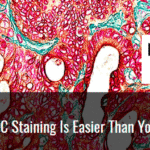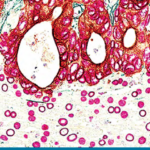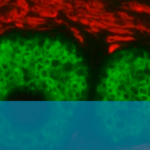Tips to get the most out of IHC experiments
Products are for professional/laboratory use only.
In the early 1940s, American physician Albert Coons labeled an antibody with a fluorescent marker.
This started the field of immunohistochemistry (IHC), in which an antibody can be used to identify and locate other molecules within a cell. Earlier this month, a search for immunohistochemistry on PubMed returned 643,834 articles. Clearly, Coons started a revolution in molecular biology. Today, scientists can choose from a broad range of IHC reagents. At times, this can be overwhelming.
Before going much farther: Just what is IHC? “The meat and potatoes of IHC involves a primary antibody and a secondary detection reagent to look for color development in a precise spot of tissue, ” explains Craig Pow, director of technical services at Vector Laboratories. IHC can be used to visualize the presence or absence of antigens in a tissue section. A scientist knows that the targeted protein is there if the color appears, and it is not there if no color develops. IHC can also be used to label multiple antigens in the same sample, through the use of multiple colors.
“Scientists can look for up and down regulation of specific proteins in different states, like normal, tumor, age-related,” Pow explains. “One protein might up or down regulate other proteins.”
Beyond just seeing the IHC label in a sample, a scientist can see precisely where the target is located. For example, scientists can see which cellular compartments include an antigen and which ones do not. “With IHC,” says Pow, “morphological aspects and structures of tissue are important, because visualizing the expressed antigens might, for instance, help clinicians locate disease.”
Technical tips
When shopping for IHC reagents, a few characteristics must be considered. For primary antibodies, notes Christoph Eckert, an IHC expert at ChromoTek, look for three things: specificity, sensitivity, and validation.
It is crucial that the primary antibody only recognizes the target antigen and that this has been determined through rigorous evaluation. The level of sensitivity that is required for the secondary detection reagent depends on the target. “If you’re looking for keratin in skin, that’s like looking for icing on cake,” Pow says. “You know it will be there.” So, that target doesn’t take the most sensitive technology. To monitor up or down regulation, proteins expressed at trace levels or unknown targets, scientists should utilize more sensitive technology to reduce the odds of a false negative.
Eckert encourages scientists to use antibodies that are available from various host species. This would help validate results, as well as streamline the workflow for a given antibody/tissue assay. “If the primary antibody is raised against a rabbit antigen, used in rat tissue,” Pow notes, “the scientist should ensure that the primary antibody recognizes the antigen expressed in rat.”
Purchase the best IHC reagents that fit the level of the experiment being performed.
Background signal also plays a role in the results of an IHC experiment. In a perfect world, scientists look for no background. Although that is theoretically ideal, it is impractical. There will always be some background, particularly in a heterogeneous tissue section. The question is: How much background can there be before the result is a false positive stain. “As long as it doesn’t interfere with the interpretation of specific staining, you can get by with some background,” says Pow.
Last but certainly not least, an effective IHC system provides consistent results. An IHC stain should produce the same results on every slide, every time it is performed. If actin, for example, exists in one section and the labeling reveals it, a scientist expects the same results in other sections containing actin. Sometimes, though, sectioning through the sample can remove the desired antigen. One way to increase consistency is by using pre-diluted or RTU (ready to use) detection reagents, which reduce the potential for errors in preparing the reagents.
Overall, IHC methods should provide robust, reproducible, and accurate results. To get that, purchase the best IHC reagents that fit the level of the experiment being performed.
IHC checklist
To help scientists get the most from IHC studies, Pow offers these three top tips. In order of importance, he starts with controls. First use positive and negative controls in every experiment. For a positive control, use the primary antibody on a test tissue that you know expresses that antigen. For a negative control, run the same protocol without the primary antibody. “If you see staining, then the secondary reagent is picking up something else,” Pow explains.
Second, make sure to use a validated primary antibody that is specific for the target antigen that is being studied. Although a vendor should validate its antibodies, the end user should confirm performance.
Third, Pow says, “optimize the conditions for each application.” He adds, “Just because an IHC experiment works in rat muscle, that doesn’t mean that it works the same in other rat tissues or mouse tissue.” To optimize an application, look at everything—times, dilutions, every variable.
To ensure that IHC results reflect the true nature of a protein being studied, these steps should be taken in every case. Researchers should expect documentation from the vendor on any IHC reagent that they receive. In a time when many in the general public question the validity of scientific research, every researcher should take every precaution to ensure the highest odds of reporting accurate results. These precautions start at the beginning. In IHC experiments, that means applying the best tools—from antibodies to detection—and using well-controlled experiments. Otherwise, modern research makes a mockery of Coon’s discovery.
Image: Metastatic cancer cells (red) invading mouse liver. Image courtesy of Vector Laboratories.
Original post featured on the Vector Laboratories blog.







